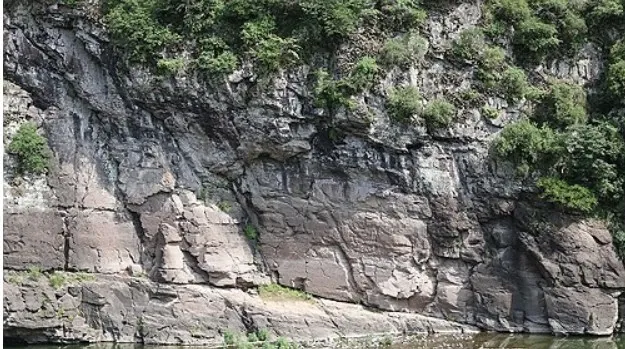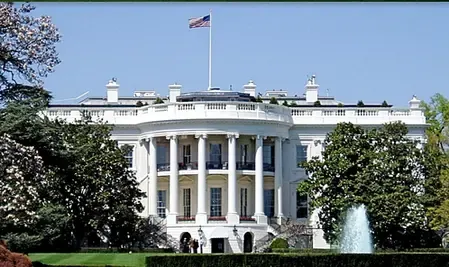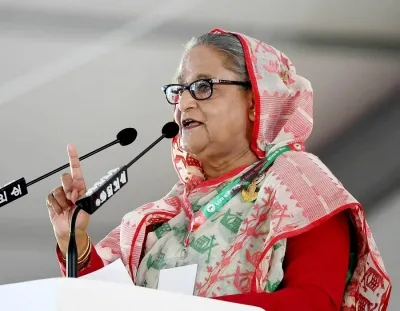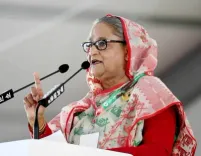What Makes South Korea's Prehistoric Petroglyphs a UNESCO World Heritage Site?

Synopsis
Key Takeaways
- The petroglyphs date back over 6,000 years, showcasing early human creativity.
- They are located along the Bangucheon Stream in Ulsan, South Korea.
- Recognized as UNESCO World Heritage sites, they highlight significant cultural value.
- Preservation efforts are ongoing due to challenges from fluctuating water levels.
- South Korea now has a total of 17 UNESCO World Heritage entries.
Seoul, July 12 (NationPress) A remarkable collection of prehistoric rock engravings located in the southeastern region of South Korea has officially been included in the UNESCO World Heritage list, as announced by the nation's cultural agency on Saturday.
This decision was reached during the 47th session of the UNESCO World Heritage Committee held in Paris, where the "Petroglyphs along the Bangucheon Stream" were acknowledged for their exceptional cultural significance.
These carvings, etched into the steep cliff faces along the Bangucheon Stream—a tributary of the Taehwa River in Ulsan, approximately 360 kilometers southeast of Seoul—illustrate hunting scenes and animals that are believed to date back to the prehistoric period.
The listing was highly anticipated after the International Council on Monuments and Sites (ICOMOS), which advises UNESCO, recommended the inclusion in May. ICOMOS's recommendation is often viewed as an initial endorsement for World Heritage designation.
According to the ICOMOS assessment, the committee noted that these petroglyphs provide remarkable evidence of a rock art tradition that has persisted for about 6,000 years.
It was emphasized that the realistic portrayals and unique compositions reflect the artistic abilities of the ancient inhabitants of the Korean Peninsula. The committee described the carvings as "masterpieces born from the creativity of prehistoric individuals."
With this latest recognition, South Korea now boasts 17 entries on the UNESCO World Heritage list.
The newly recognized site features two prominent panels: the Bangudae petroglyphs located in Daegok-ri and the Cheonjeon-ri petroglyphs, both deemed rare and important examples of early artistic expression in East Asia.
The Daegok-ri panel, commonly known as the "Bangudae petroglyphs," stands as the largest rock art site on the Korean Peninsula, extending over 30 meters. The carvings are primarily found on a rock face approximately 4.5 meters high and 8 meters wide, showcasing images of both sea and land animals, as well as hunting scenes.
Discovered in 1971 and designated as South Korea's National Treasure No. 285, this panel is recognized for containing the world’s oldest known representation of whale hunting.
A report from the Ulsan metropolitan city in 2023 indicated that 312 distinct engravings were identified on the panel using advanced three-dimensional scanning techniques.
The Cheonjeon-ri petroglyphs, located roughly 2 kilometers from the Daegok-ri site, were discovered in 1970, a year earlier than the Daegok-ri site. This site features over 620 figures, symbols, and drawings carved into a rock surface measuring about 2.7 meters high and 10 meters wide. It has now been designated as National Treasure No. 147, as reported by Yonhap news agency.
Despite their historical significance, the petroglyphs have faced preservation issues due to frequent submersion caused by varying water levels at the nearby Sayeon Dam, constructed in 1965 before the petroglyphs were uncovered.
Over the last decade, the carvings have been submerged for an average of 42 days per year.
Officials and specialists have been deliberating on preservation strategies, which include modifying the dam's water levels and constructing temporary embankments.
Authorities are now planning to install floodgates at the Sayeon Dam spillway to better manage water levels and safeguard the site. The frequent flooding was a significant factor in the 15-year wait for the petroglyphs to achieve World Heritage status after being placed on UNESCO's tentative list in 2010.
In their resolution, the World Heritage Committee urged the South Korean government to keep the World Heritage Centre updated on the progress of construction work related to the dam.









